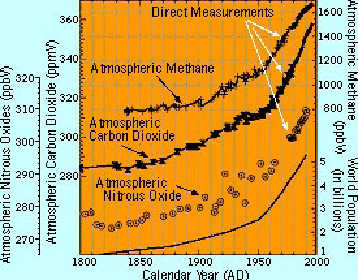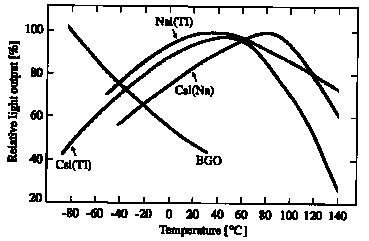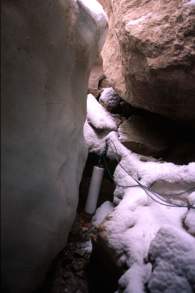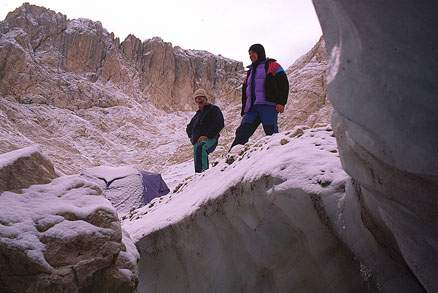

The scientific case.
The study of the snow accumulation at the Earth's cold regions, glaciers and polar ice-caps, is of great importance in fields like glaciology, meteorology and climatology. One way to measure snow deposition history is by visual stratigraphy the other is by identifying layers of chemicals or particles that vary periodically with seasons or are associated with historical events such as volcanic eruptions and thermonuclear tests or accidents. Because of their well-known dates, these events serve as characteristic reference levels in snow. Artificial and natural radionuclides present in the ice sheets of the cold regions are currently used, in glaciological studies, to determine the average rate of snow accumulation over the last 40 years and have also been widely used as atmosferic tracers to understand the transport and circulation of continental, tropospheric and stratosferic air masses. Chemical analysis has given the possibility to determine, as shown in Fig. 1, the evolution of the environmental pollution produced by human activity 1 while, as shown in Fig. 2, particle analysis in ice samples, as a function of depth, has been used to determine absolute time markers 2 since the peaks found were linked to nuclear explosions in fifties and sixties and to the Chernobyl accident 3 (1986).

Fig. 1 Evolution of the environmental pollution
|
![Fig. 2 Beta activity vs. depth in ice core (from ref. [2]).](./images/Fig02.gif)
Fig. 2 Beta activity vs. depth in ice core
|
Chemical and particle analysis usually requires samples from snowpits or ice
cores to be gathered and returned to the laboratory. Since these samples are
often taken from places that are remote, handling and shipping the samples can
be very difficult since some places are of difficult access. This is
particularly true in the higher parts of mountain regions that are very
sensitive to small amounts of radioactive contaminants and offer the unique
opportunity to detect in advance small changes in the atmospheric composition.
Therefore, it would be useful to have a way to determine, in the field, one or
more absolute time markers in the snow
4
. This would allow the selection of samples for the specific time intervals of
interest and could in some case eliminate the need for sample retrieval.
It has been found3,4 that in-situ measurements of 137Cs
g
-rays (half-life = 30.17 yr) from fallout can be used as an absolute time
marker. This implies lowering a detector down in bore-holes or along trench
profiles in the snow to measure the characteristic 662 keV
g
-rays emitted by Cs-137. Among the main fission product from nuclear tests or
accidents, Cs-137 is the gamma -emitter with the longest half-life.
The
g
-ray detection method is of great interest for the
Italian Glaciological Community
involved in national and international glaciological studies some of which
are also included in the activities of the
Ev-K2-CNR Project
and of the new Istituto Nazionale per la Ricerca Scientifica e Tecnologica
sulla Montagna (INRM).
Main interests of this kind of research.
The information that can be collected by this kind research is very useful in
order to
evaluate local and global change processes, including the radio-chemical
pollution, induced by human activity.
International scientific communities are promoting studies in remote areas and
at high altitude to monitor and control :
Future perspectives.
The detector will be used in glaciological studies in snowfields and high altitude glaciers (Gran Sasso, Mt. Rosa, Mt. Bianco, Greenland, Antarctic and Himalaya). In particular it will be used during the " Roma 8000 " expedition at the Cho-Oyu mountain in Tibet (15August-15 October 2000). This expedition related to the Italian activities for the year 2002 proclaimed by the UN to be the " International Year of the Mountains ", is also sponsored by INFN and will represent for the detector the first very high altitude test.
Technical aspects.
A . Sensitivity, resolution and efficiency .
A gamma-ray spectrometer based on a NaI(Tl) scintillator crystal coupled with a
photomultiplier, has a high efficiency in the Cs-137 gamma-ray region and
enough resolution to discriminate the Bi-214 peak at 609keV which is of natural
origin. In order to achieve a very low minimum detectable signal, a great
scintillator volume is needed, and since the bore-holes in snow have a minimum
diameter of 100 mm, a cylindrical scintillator crystal with 76 mm diameter and
length of about 100 mm was selected.
The method to measure 'in situ' radioactive fallout, monitoring the emission
at 662 keV of Cs-137 by using a NaI(Tl) scintillator detector coupled with a
photomultiplier tube and a multichannel analyser was proposed in 1981, by
Pinglot and Pourchet3. Their measurements have shown that the gamma activity
can be detected 'in situ' and that it is strongly correlated with the
radioactivity measured in samples. The limit of their system was the
portability, being the weight of the whole detector system of about 250 kg !
In 1994, Dunphy, Dibb and Chupp4 proposed a lighter portable system based on a
NaI(Tl) scintillator detector computer controlled. Their measurements were done
near a permanent base by using a standard AC power source which is not usually
available - or portable - in some remote areas, like high altitude glaciers.
For this reason GEDI will develop a completely portable instrument that can be
easily carried and handled by a small team without any external support and the
scintillator, the photomultiplier, the high-voltage divider and the
preamplifier will be assembled and housed in a thin stainless steel
water-resistant cylinder in order to be able to work in harsh environmental
conditions.
B . Power supply.

Fig. 4. Responces of NaI(Tl)and of other scintillators
|
The detector can be exposed to temperatures as low as -50°C. Since the temperature gradient can damage the detector and affects the detector response (Fig. 4) changing the position and the width of the detected peak, the stainless steel cylinder will be wrapped with a flexible heater controlled by a thermostat. To protect from water and mechanical shocks, the all system (detector, heaters and thermostat) is housed in an acrylic tube. The temperature is monitored (inside and outside the housing tube and in the environment) by using semiconductor temperature sensors. |

Fig. 8. The gamma-ray spectra of the 1999 sample (layer 2). The peaks due to 662 keV Cs-137 and 609 Bi-214 gamma-rays are indicated.
References.
Appendix : Difficulties in performing 'in situ' measurements at high altitude:
2. Scientists must move on glaciers so the must be familiar with crampons and ice-axes.

|

|
3. Weather can change very fast so some times it is necessary to work at very low temperatures.
